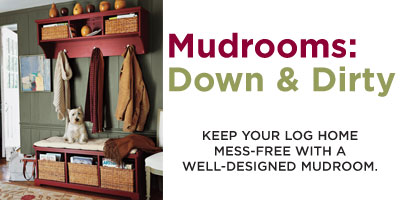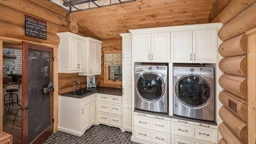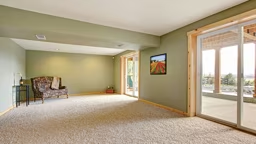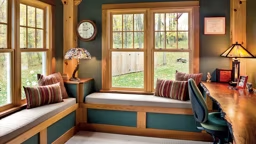 Ah, the mudroom. That ever-so-useful transitional space between the great outdoors and your log home’s interior. Like a utility room morphed with a walk-in closet, mudrooms are great for storing coats, boots, sporting gear—you name it. Mudrooms can range anywhere from a back hallway equipped with free-standing cubbies to a full-blown multipurpose room. In many cases, the mudroom also serves as the house’s laundry, making it easy to toss dirty clothes straight into the wash after a day of skiing or sledding. But don’t be fooled by labels. Just because it’s called a mudroom (yuck!), that doesn’t mean it can’t be just as beautiful as the rest of your log home. As this smart space has increased in popularity, so have design elements and decorating possibilities—making it easy (and even fun) to create a customized mudroom to suit your family’s needs. Where With All Location, location, location—it’s key to any functional design. “The optimal place for a mudroom is just off of the garage,” suggests Gary Pickens, director of sales and marketing for Lodge Logs in Boise, Idaho. Then you can enter through the garage, step into the toasty mudroom, take off your wet garb and store your muddy gear. Another great location? The basement. “Many log homes have walkout basements with a separate entrance,” says Gary. “If you put your mudroom down there, it will still serve the same purpose—and keep your upstairs entrances neat and dry for visitors.” Down Under There’s no telling what you (and the cat) might drag into your mudroom, so carefully consider what goes underfoot. “Mudroom floors take a beating on a daily basis, so you’ll want a very dur-able material,” says Gary. Atlanta-based interior designer Judith Slaughter says tile made from ceramic or unpolished stone gets her vote as the most durable choice. “Tile is very practical and virtually indestructible. It doesn’t scratch or wear—and it’s very easy to clean,” says the designer, who also suggests choosing a dark color for both the tile and grout to camouflage dirt. Concretes, laminates and vinyl also withstand wear. But they can be slippery when wet. Putting down rugs or mats with grippers underneath will help, as will keeping mudroom floors as clean as possible. In terms of flooring materials to avoid, Gary says linoleum is a no-go. “All it takes is a nick from someone’s boot and you’ve got the potential for serious water seepage underneath the floor,” he warns. Wood doesn’t make much sense for a mudroom floor either, due to potential water damage. Whatever flooring material you choose, a couple of doormats (including a bristle-top style outside and a water-absorbent rug inside) will fight grime. Side Project When it comes to mudroom walls, log homes have a definite advantage. “Since log walls typically have a sealant on them, they aren’t nearly as susceptible to damage as a conventionally framed house would be,” says Gary. Judith agrees. “Logs are incredibly practical and much easier to maintain. If a log wall gets a little nicked up, it’s not a big deal. With sheetrock, it’s far more noticeable.” Log walls are also super-sturdy, providing a great surface for attaching coat hooks, shelves, old-fashioned luggage racks and other storage-friendly wall fixtures. Storage Solutions S torage space is the most essential element of a mudroom. In homes with children, consider using self-stick hooks or stackable shelves that can be raised as your kids grow. Lockers and cubbies are ideal for stashing everything from knapsacks to earmuffs. Give everyone in the house a personal bin labeled by name. This makes locating the little ones’ stuff a breeze when you’re hustling to get out the door. “Don’t forget to include a small table or another surface where you can drop your keys when you walk inside,” suggests Judith. “Mudrooms are a sure cure for people who tend to misplace things around the house!” Whether freestanding or built-in, storage benches offer a place to sit down while pulling off wet boots and snowsuits. Look for benches with seats that flip up to reveal extra room for storing pet food or clean towels. Standard kitchen cabinets can also work in a mudroom. “They’re especially helpful if you have a washer and dryer in the mudroom,” says Gary. “With upper and lower cabinets, you can store things like laundry detergent on one level and utility products on another.” So what’s the hottest trend in mudrooms today? “A lot of people are requesting doggie baths with handheld showers,” says Gary. “Ranchers love them for cleaning off their boots, but plenty of people actually use them to wash the family pet.” If you don’t have the square footage for an all-out mudroom, you can still incorporate similar capabilities elsewhere in your home. Even one spare corner is big enough to put a coat rack and an umbrella stand. Just think about which items (newspapers, shoes, bags) tend to pile up and drive you crazy in your foyer or mudroom. You’re sure to find an attractive storage product to keep them out of sight. |
Mudrooms: Down & Dirty | Mudroom Design Ideas
Keep your log home mess-free with a well-designed mudroom.











